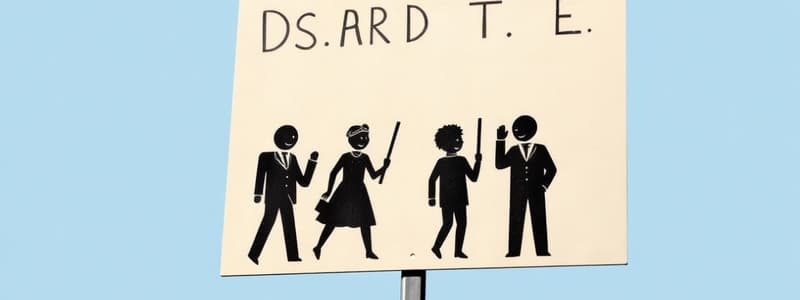Podcast
Questions and Answers
What was a common experience for African Americans in the 1960s when entering public establishments?
What was a common experience for African Americans in the 1960s when entering public establishments?
- They received special treatment compared to others.
- They were often invited to join social events.
- They were regularly denied service and faced scorn. (correct)
- They were always welcomed with open arms.
What societal practice was used to maintain separation among races in the 1960s?
What societal practice was used to maintain separation among races in the 1960s?
- Segregation laws. (correct)
- Integration laws.
- Universal education policies.
- Promotion of diversity.
How did African Americans respond to discrimination in the 1960s?
How did African Americans respond to discrimination in the 1960s?
- They attempted to leave the country.
- They sought refuge in isolation.
- They accepted it without protest.
- They organized and marched for their rights. (correct)
What characterized the daily lives of African Americans under discrimination in the 1960s?
What characterized the daily lives of African Americans under discrimination in the 1960s?
What motivated African Americans to continue fighting for their rights despite the risks in the 1960s?
What motivated African Americans to continue fighting for their rights despite the risks in the 1960s?
Flashcards
Discrimination
Discrimination
The unfair treatment of a person or group based on their race, often leading to denial of opportunities and rights.
Segregation
Segregation
Laws that kept people of different races separate in public places like schools, transportation, and drinking fountains.
Civil Rights Marches
Civil Rights Marches
Peaceful gatherings and demonstrations used to advocate for equality and fight against injustice.
Civil Rights Movement
Civil Rights Movement
Signup and view all the flashcards
Scorn
Scorn
Signup and view all the flashcards
Study Notes
1960s African American Discrimination
- African Americans faced severe racial discrimination in the 1960s.
- They were denied service in restaurants and stores and treated as second-class citizens.
- Segregation laws separated African Americans from whites in schools, buses, and public facilities.
- This discrimination permeated all aspects of daily life.
- Civil rights activists marched and organized to demand equality, facing potential violence.
- The struggle for equality was ongoing and necessary to achieve social change.
Studying That Suits You
Use AI to generate personalized quizzes and flashcards to suit your learning preferences.




